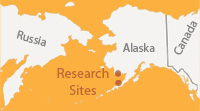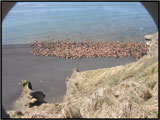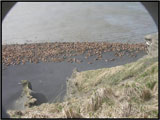 |
 |
 |
 |
 |
 |
 |
 |
Results
Cameras at the five sites captured data during the season of May-September 2011. For each of the sites, the timeline below shows (1) when the cameras were deployed, (2) when the first walrus was spotted at that location, (3) the date when the largest number of animals were counted on that site, and (4) the date of the last image taken by the cameras.

The team collected census data by examining the photos at the end of the season and counting the walruses. Below are images captured from the haulout site on Cape Seniavin on August 4th, 2011. On this day, over 1,400 male walruses were counted hauled out in this single spot.
Click on the thumbnail images below to see the larger versions:
Researchers decided to add more cameras at this site in 2012 to avoid blind spots like the one created by the rock in the pictures above.
On Hagemeister Island, cameras recorded the disturbance event seen below. Click on the thumbnail images below to see the larger versions:
In the fourth photo you can see that these walrus quickly returned to the beach. The scientists couldn't see what caused the disturbance, but they think it was likely a bear or other land-based predator nearby.
With clear images like the ones above, Dr. Polasek and her team agreed that camera monitoring at these remote sites is both possible and useful for understanding Pacific walrus behavior. Unfortunately, the type of camera the Alaska SeaLife Center team installed for the 2011 season tended to fail often. Many of the cameras stopped taking pictures before the last walrus left the site at the end of the season. So the 2011 data set isn't as complete as the team had hoped. They knew camera monitoring worked, but they needed to find a better type of camera.
In 2011, the scientists were able to begin establishing their baseline. In 2012, they purchased new, more reliable cameras and added more haulout sites to their study. They're continuing to work on their baseline using male walrus in Bristol Bay, but with the help of the residents of Point Lay they've also set up their first cameras along the Chukchi Sea.
Check the updates section for images captured in the second season!
















